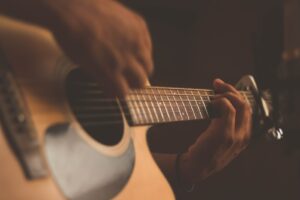A capo is a device commonly used in guitar playing to change the strings’ pitch by clamping down at a specific fret.
It is placed across the fretboard and clamps down on specific frets, effectively shortening the playable length of the strings.
This allows musicians to play in different keys without changing chord formations or fingerings.
While capos are commonly used on guitars, they are not typically used on bass guitars.
Due to the thicker strings and lower pitch of the bass guitar, using a capo can cause issues with intonation and string tension.
Additionally, the capo may not effectively clamp down on the wider and flatter fretboard of a bass guitar.
Major Consequences Of Using Capo In Bass Guitar
Altered Intonation
Using a capo on the bass guitar can impact the intonation, causing certain notes or chords to sound out of tune.
To ensure accurate pitch across the fretboard, adjustments may be necessary.
It’s important to carefully assess the intonation and make tweaks required to maintain proper tuning and ensure harmonious playing.
String Buzz And Muting
If a capo is placed incorrectly on a bass guitar or doesn’t apply enough pressure, it can lead to string buzzing or muting.
Proper placement and sufficient pressure are vital to prevent these issues and maintain optimal sound quality.
Uneven String Tension
When a capo is used on a bass guitar, it can create uneven string tension along the fretboard.
Some strings may feel tighter or looser than others, affecting the overall balance and feel of the instrument.
Limited Low-End Frequencies
Using a capo on the bass guitar may result in a limitation of access to the lower register of the instrument.
The capo effectively raises the pitch, potentially altering the instrument’s tonal capabilities and restricting the player’s ability to explore the lower frequency range.
Reduced String Articulation
Using a capo on the bass guitar can diminish the instrument’s inherent string articulation and dynamics.
The capo alters the natural response of the strings, potentially reducing the range of tonal variation and limiting the ability to convey nuanced playing techniques and musical expression.
Altered Timbre And Tone
When a capo is used on a bass guitar, it can modify the timbre and tone of the instrument.
The capo’s influence on the instrument’s tonal qualities should be carefully considered to ensure the desired musical cohesion and overall sound of the bass guitar within a musical context.
Limited Capo Compatibility
The wider neck and thicker bass guitar strings present challenges when searching for a suitable capo that fits securely.
Finding a capo that properly accommodates the unique dimensions of a bass guitar may be more challenging, requiring careful consideration of compatibility to ensure a secure and effective fit.
Alternatives For Capo In Bass Guitar
Transposition By Shifting
Instead of using a capo, guitar players can transpose by shifting their hand positions along the fretboard.
It is essential in playing the same chord shapes or notes in different positions to achieve the desired key change.
Alternate Tunings
Exploring alternate tunings on the bass guitar can provide a different tonal palette and enable playing in other keys without needing a capo.
Experiment with drop tunings or open tunings to achieve desired pitch changes.
Pitch-Shifting Effects
Utilize pitch-shifting effects pedals or digital processors to alter the pitch of the bass guitar in real time.
These effects can mimic the capo’s functionality by shifting the pitch without physically changing the fretboard.
Transcription And Adaptation
Instead of using a capo, transcribe songs or basslines to different keys and adapt them to suit your desired performance.
This approach allows for a more personalized interpretation without relying on capo usage.
Collaborative Adjustments
Communicate with other musicians and adapt the overall key of a song to suit the instrumentation and vocal range better.
Make collective adjustments to the key or explore alternative arrangements to accommodate the bass guitar without needing a capo.
What Is The Purpose Of Using A Capo On A Guitar?
A capo is a small device that can be clamped onto the neck of a guitar.
While guitar players commonly use it, bassists rarely use a capo.
The main function of a capo is to change the key signature of the instrument without changing the hand positions on the neck.
It effectively acts as a movable nut or fret, allowing the player to play familiar chord shapes or notes in different keys by shortening the playable length of the strings.
Does Using A Capo On A Guitar Have An Effect On Its Tone?
The tone of a guitar is primarily influenced by various factors such as the type of wood, pickups, and the player’s technique.
However, when using a capo, the tone can be indirectly affected if the capo causes issues with tuning or string buzzing.
If the capo isn’t applied evenly across the strings or doesn’t hold them tightly enough, it can lead to buzzing or muting, impacting the overall tone.
Additionally, some capos may cause slight tuning discrepancies when applied, though higher-quality capos tend to minimize this issue.
What Are The Major Challenges When Using A Capo On Bass Guitar?
Using a capo on the bass guitar can present some challenges.
Due to the thicker strings and lower pitch of a bass guitar, finding a capo that fits properly and applies even pressure across all the strings can be difficult.
Bass guitars also have wider and flatter fretboards compared to guitars, making it more challenging for a capo to clamp securely.
Additionally, the capo can affect the intonation, requiring adjustments to maintain proper tuning.
Are There Any Specific Capos Designed For Bass Guitars?
While capos are commonly used on guitars, there aren’t many specific capos explicitly designed for bass guitars.
This is because the wider neck and thicker strings of a bass guitar pose challenges for traditional capo designs.
However, there are certain capos available that can accommodate bass guitars.
Some capos feature adjustable tension or wider clamping areas to properly fit the bass guitar’s neck.
How Do I Choose The Right Capo For My Bass Guitar?
When choosing a capo for your bass guitar, there are a few factors to consider.
Ensure the capo is designed specifically for bass guitars or has adjustable features to accommodate the wider neck and thicker strings.
Trying out different capo styles, such as spring-loaded or adjustable tension capos, is beneficial to find the one that suits your playing style and preferences.
Additionally, seek recommendations from fellow bassists or consult a music store professional to find a reliable, durable capo compatible with your bass guitar.




